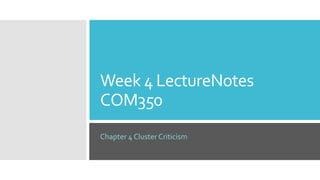Week 4 lecture notescom350
•Download as PPTX, PDF•
1 like•60 views
Week 4 lecture notes COM 350 Cluster criticism
Report
Share
Report
Share

Recommended
Recommended
More Related Content
Similar to Week 4 lecture notescom350
Similar to Week 4 lecture notescom350 (20)
Representation and organization of knowledge in memory

Representation and organization of knowledge in memory
Concept Explication - Theoretical Issues - Intro to Quantitative 

Concept Explication - Theoretical Issues - Intro to Quantitative
Changing assessments using tri archic intelligence theory.

Changing assessments using tri archic intelligence theory.
From TeacherTo assist you with preparing the Week 7 assignment.docx

From TeacherTo assist you with preparing the Week 7 assignment.docx
More from Olivia Miller
More from Olivia Miller (20)
Neo aristotelian criticism Week 3 LectureNotes COM350

Neo aristotelian criticism Week 3 LectureNotes COM350
Recently uploaded
https://app.box.com/s/7hlvjxjalkrik7fb082xx3jk7xd7liz3TỔNG ÔN TẬP THI VÀO LỚP 10 MÔN TIẾNG ANH NĂM HỌC 2023 - 2024 CÓ ĐÁP ÁN (NGỮ Â...

TỔNG ÔN TẬP THI VÀO LỚP 10 MÔN TIẾNG ANH NĂM HỌC 2023 - 2024 CÓ ĐÁP ÁN (NGỮ Â...Nguyen Thanh Tu Collection
God is a creative God Gen 1:1. All that He created was “good”, could also be translated “beautiful”. God created man in His own image Gen 1:27. Maths helps us discover the beauty that God has created in His world and, in turn, create beautiful designs to serve and enrich the lives of others.
Explore beautiful and ugly buildings. Mathematics helps us create beautiful d...

Explore beautiful and ugly buildings. Mathematics helps us create beautiful d...christianmathematics
Mehran University Newsletter is a Quarterly Publication from Public Relations OfficeMehran University Newsletter Vol-X, Issue-I, 2024

Mehran University Newsletter Vol-X, Issue-I, 2024Mehran University of Engineering & Technology, Jamshoro
Recently uploaded (20)
TỔNG ÔN TẬP THI VÀO LỚP 10 MÔN TIẾNG ANH NĂM HỌC 2023 - 2024 CÓ ĐÁP ÁN (NGỮ Â...

TỔNG ÔN TẬP THI VÀO LỚP 10 MÔN TIẾNG ANH NĂM HỌC 2023 - 2024 CÓ ĐÁP ÁN (NGỮ Â...
Food safety_Challenges food safety laboratories_.pdf

Food safety_Challenges food safety laboratories_.pdf
This PowerPoint helps students to consider the concept of infinity.

This PowerPoint helps students to consider the concept of infinity.
Explore beautiful and ugly buildings. Mathematics helps us create beautiful d...

Explore beautiful and ugly buildings. Mathematics helps us create beautiful d...
Micro-Scholarship, What it is, How can it help me.pdf

Micro-Scholarship, What it is, How can it help me.pdf
Kodo Millet PPT made by Ghanshyam bairwa college of Agriculture kumher bhara...

Kodo Millet PPT made by Ghanshyam bairwa college of Agriculture kumher bhara...
UGC NET Paper 1 Mathematical Reasoning & Aptitude.pdf

UGC NET Paper 1 Mathematical Reasoning & Aptitude.pdf
Fostering Friendships - Enhancing Social Bonds in the Classroom

Fostering Friendships - Enhancing Social Bonds in the Classroom
Week 4 lecture notescom350
- 1. Week 4 LectureNotes COM350 Chapter 4 Cluster Criticism
- 2. Cluster Criticism Developed by Kenneth Burke, a specialist in symbol-systems and symbolic action Burke said •rhetoric takes place through the process of identification •rhetoric functions to name or define situations, meaning a speech or a poem is a “strategy for encompassing a situation.” •rhetoric is a rhetor’s solution to a perceived problem. Consubstantial: an association between people who share beliefs, values, occupations, friends, and physical objects. Burke said consubstantial is the same as identification
- 3. A rhetorical artifact or act provides assistance to its audience as a vocabulary of thoughts, actions, emotions may encourage acceptance of a situation provides an orientation to a situation reveals the worldview, the terministic screen, of the rhetors who created it
- 4. A cluster analysis provides insights into the meanings of key terms allows the researcher to assume some structure among the terms or objects. is a method for examining the terministic screen of rhetors. provides insights into the worldviews of rhetors by analyzing the termanistic screens
- 5. Cluster analysis is useful when a researcher explores the nature of the data or to examine a previously stated hypothesis. is used when identifying groups within the data has no statistical basis and cannot be used to draw inferences from a sample to a population.
- 6. How does cluster analysis work? The objective is to define the structure of the data by placing the most similar observations into groups. Conduct cluster criticism in three steps: 1-identify the key terms in the artifact 2- chart the terms that cluster around the key terms 3- discover an explanation for the artifact. Select an artifact (discursive and nondiscursive- long and complex enough) Analyze the object Identify key terms (either repeated or if removed would change the impact of the paper; god and devil terms) Chart the cluster Discover an explanation of the artifact Formulate a research question
- 7. Key terms are nouns. Find no more than 6 terms that seem to be significant to the rhetor. Significance is determined by frequency or intensity If the artifact is nondiscursive, the key terms are visual elements: color, shape and image Chart the terms that cluster around each of the key terms.
- 8. Agon analysis examination of opposing terms. Look for terms that are opposites or that contradict other terms. Chart all terms and the clusters around the terms. Categorize the clusters Identify the important clusters—those with the most explanatory value for the artifact. Make a statement of the significance of the clusters. Let the cluster suggest insight into the rhetor’s worldview
- 9. Formulate a research question Formulate a research question Perhaps about the strategies used to accomplish particular objectives, or the kinds of meanings that are being communicated for rhetorical processes or public controversaries. Write the essay.